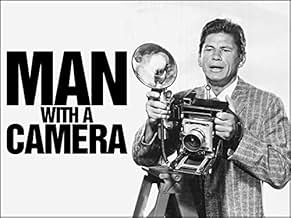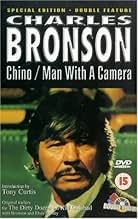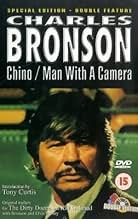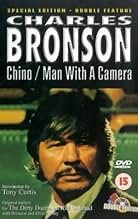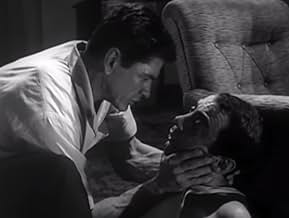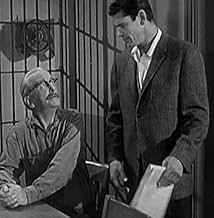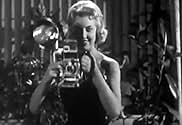El ex camarógrafo de combate Mike Kovac es ahora un fotógrafo freelance en Nueva York, especializado en encargos difíciles y peligrosos en los que puede conseguir el tipo de imágenes que otr... Leer todoEl ex camarógrafo de combate Mike Kovac es ahora un fotógrafo freelance en Nueva York, especializado en encargos difíciles y peligrosos en los que puede conseguir el tipo de imágenes que otros fotógrafos no pueden o no quieren hacer.El ex camarógrafo de combate Mike Kovac es ahora un fotógrafo freelance en Nueva York, especializado en encargos difíciles y peligrosos en los que puede conseguir el tipo de imágenes que otros fotógrafos no pueden o no quieren hacer.
Explorar episodios
Opiniones destacadas
The points made by the exquisitely named Welsh gentleman in the previous review are fair enough in a 2004 context but what people like him always forget is the HISTORICAL context. No, Charlie Bronson did NOT have a digital camera in 1958, so he had to make do with the existing technology.
The point is that this series was made FOR ITS TIME and so the only test we can apply in 2004 is: "was it entertaining?" And, like most of Mr Bronson's work, yes, it was entertaining.
Providing you maintain the right perspective and keep old series and old films generally within the context of their time, you can apply a meaningful judgment of them. It utterly amazes me how so many people can dismiss something because it was made in the days before computerised special effects became available. If these special effects films nowadays are so good, why are the cinemas so empty?
Lets take a modern example of a film that is closely related to contemporary technology: this "Matrix" rubbish. Is that entertaining? Is it hell. It is absolute garbage.
"Man with a Camera" is completely watchable. I agree that Charlie's subsequent superstardom tends to detract as you look back on it, but it is certainly worth watching again for its own sake.
If it's on a nostalgia channel near you any time, believe me the story lines alone make it worth watching. And Charlie was always worth watching anyway.
The point is that this series was made FOR ITS TIME and so the only test we can apply in 2004 is: "was it entertaining?" And, like most of Mr Bronson's work, yes, it was entertaining.
Providing you maintain the right perspective and keep old series and old films generally within the context of their time, you can apply a meaningful judgment of them. It utterly amazes me how so many people can dismiss something because it was made in the days before computerised special effects became available. If these special effects films nowadays are so good, why are the cinemas so empty?
Lets take a modern example of a film that is closely related to contemporary technology: this "Matrix" rubbish. Is that entertaining? Is it hell. It is absolute garbage.
"Man with a Camera" is completely watchable. I agree that Charlie's subsequent superstardom tends to detract as you look back on it, but it is certainly worth watching again for its own sake.
If it's on a nostalgia channel near you any time, believe me the story lines alone make it worth watching. And Charlie was always worth watching anyway.
A very entertaining series from 1958 that had interesting, fast paced, coherent stories, good action (although like most crime shows, it usually ended with a brawl), intelligible dialogue, attractive women and state of the art camera equipment. Bronson's lifelong Spartan, cool style was always compelling. He walks like a cat, never hits on girls but is protective of them at the risk of his own life and delivers haymakers to the criminals.
I knew nothing about this series until stumbling across the title while checking Mr. Bronson's IMDb page to see what I'd missed among his legendary body of action flicks. Glad I did.
Theses stories are rather uneven in plotlines, but most are reasonably well done for TV fare of that era - including mostly above-average fight scenes. The casting is sound. A perk of seeing this now is catching future stars (Angie Dickinson, Gavin MacLeod, Sebastian Cabot, William Conrad, among others) in pre-fame roles. The format sending Kovac to many locales to snap his pix allowed a raft of one-and-dones for anyone with a union card.
But most important is this phase in the evolution of the Bronson persona we vividly remember. Few recall when Katherine Hepburn easily beat him up in 1952's Pat and Mike. By this time, he'd changed his name from Buchinsky, en route to becoming the hero of so many gritty westerns and contemporary crime flicks. This Kovac character was tough, but not yet primed to go Full Bronson on the bad guys. His won-lost ratio in the fist fights and shootouts was still lower than it was about to be for the next few decades. The best was yet to come, but this was still pretty good.
Theses stories are rather uneven in plotlines, but most are reasonably well done for TV fare of that era - including mostly above-average fight scenes. The casting is sound. A perk of seeing this now is catching future stars (Angie Dickinson, Gavin MacLeod, Sebastian Cabot, William Conrad, among others) in pre-fame roles. The format sending Kovac to many locales to snap his pix allowed a raft of one-and-dones for anyone with a union card.
But most important is this phase in the evolution of the Bronson persona we vividly remember. Few recall when Katherine Hepburn easily beat him up in 1952's Pat and Mike. By this time, he'd changed his name from Buchinsky, en route to becoming the hero of so many gritty westerns and contemporary crime flicks. This Kovac character was tough, but not yet primed to go Full Bronson on the bad guys. His won-lost ratio in the fist fights and shootouts was still lower than it was about to be for the next few decades. The best was yet to come, but this was still pretty good.
I've not only 'watched' the series...but watched it 'live in it's time slots'. when I was 25 years old...a young Professional Photographer myself.
Charles Bronson was most-impressive in the series. He used 35-mm film cameras and Flash Bulbs, long before Electronic Flash cameras became mainstream to the public..Polaroid Cameras was not yet invented.
The show sponsors were Sylvania 'Blue Dot'Flashbulbs and Kodak Films which EVERYONE used.
The 'Blue Dot' was Sylvania's Trademark and when the 'dot' on the flashbulb was the color-blue...you knew you had a good bulb that was guaranteed to flash. Other manufacturer bulbs sometimes failed to flash because they were 'defective', thus losing a possible great photo at cost of the film exposure and flashbulb.
The film image is captured in a split second for posterity. If you missed the shot...it was gone forever. 'Man With A Camera' got his 'shots' every time.
Every photographer developed film and made prints in a darkroom or makeshift one...was exciting times in Photography.
Charlie was the updated 'Weegee' (Live Free-Lance crime photographer in the 40's and 50's who used a 4x5 Press Camera and Flashbulkbs and covered New York City at night, and became an icon by doing so).
Charles Bronson became a Movie Icon as result of this Great Photography series, which lead him to become the Superstar he was.
This series filmed in Black & White is Historically accurate and exciting to everyone who is photography crafted. A real true-blue historical masterpiece of nostalgia.
If you get the opportunity to watch it...please do...you'll be glad you did...seeing a Superhero in the making...Take care.
~ ED Cherney
Charles Bronson was most-impressive in the series. He used 35-mm film cameras and Flash Bulbs, long before Electronic Flash cameras became mainstream to the public..Polaroid Cameras was not yet invented.
The show sponsors were Sylvania 'Blue Dot'Flashbulbs and Kodak Films which EVERYONE used.
The 'Blue Dot' was Sylvania's Trademark and when the 'dot' on the flashbulb was the color-blue...you knew you had a good bulb that was guaranteed to flash. Other manufacturer bulbs sometimes failed to flash because they were 'defective', thus losing a possible great photo at cost of the film exposure and flashbulb.
The film image is captured in a split second for posterity. If you missed the shot...it was gone forever. 'Man With A Camera' got his 'shots' every time.
Every photographer developed film and made prints in a darkroom or makeshift one...was exciting times in Photography.
Charlie was the updated 'Weegee' (Live Free-Lance crime photographer in the 40's and 50's who used a 4x5 Press Camera and Flashbulkbs and covered New York City at night, and became an icon by doing so).
Charles Bronson became a Movie Icon as result of this Great Photography series, which lead him to become the Superstar he was.
This series filmed in Black & White is Historically accurate and exciting to everyone who is photography crafted. A real true-blue historical masterpiece of nostalgia.
If you get the opportunity to watch it...please do...you'll be glad you did...seeing a Superhero in the making...Take care.
~ ED Cherney
I've never been a Charles Bronson fan, but 'Man with a Camera' was the role that brought him major attention. This was one of the very early series of the young ABC network, so it suffered from a low budget and poor production values, but was broadly hyped by ABC.
Bronson played Mike Kovac, a former combat photographer now free-lancing in New York City, specialising in getting the photographs that other lensmen can't (or don't have the guts to obtain). Ludicrously, a lot of Kovac's assignments came from the police and newspaper editors, who never seemed to have their own photographers on staff. As this was a crime show, Kovac's assignments always embroiled him in some caper, usually involving a good-looking woman. Kovac's police liaison was Lieutenant Donovan, well-played by James Flavin but stuck with the implausible cliché (dating back to Inspector Lestrade) of the cop who has to go to the independent free-lance hero for help with all the cases the cops can't handle.
One strong point of 'Man with a Camera' is that it involved the latest photographic technology, which inevitably must seem quaint from our modern standpoint. The boot of Kovac's car was converted into a portable darkroom. After he snapped his pix, he would then peel off his jacket to reveal a short-sleeved shirt (with Charles Bronson's brawny biceps). Kovacs would then ceremoniously take off his wristwatch, mix the hypo, and develop his negatives on the spot. (Wot, no Polaroids?) For special assignments, Kovac would use a miniature camera, a fisheye lens, a telephoto attachment or various other gimmicks ... all technologically accurate for the time.
The dialogue in this series tended towards the gimmicky as well. In a typical climax, Kovac went into the villain's hideout (unarmed, natch), punched the crap out of him single-handed, then threw him into the street. Lieutenant Donovan comes running along just as Kovac ominously reaches into his jacket as if drawing a weapon.
Donovan: "You're not going to shoot him, are you?"
Kovac: "After all the trouble I went to, you're darn right I'm gonna shoot him."
Then he pulls out his camera and he *shoots* the villain. Geddit? Hoo boy.
As played by monotone actor Bronson, Kovac could have been a dull stereotype. He was humanised somewhat by the presence of his immigrant father Anton, to whom Kovac frequently came for advice. The individual episodes of 'Man with a Camera' tended to have photographic titles, such as 'Close-Up on Violence', 'Double Negative', 'The Picture War'. The series boasted an impressive roster of guest stars, including Frank Faylen, Grant Williams and (pre-Batgirl) Yvonne Craig. 'Man with a Camera' may well be of great interest to Bronson fans but is not otherwise notable.
Bronson played Mike Kovac, a former combat photographer now free-lancing in New York City, specialising in getting the photographs that other lensmen can't (or don't have the guts to obtain). Ludicrously, a lot of Kovac's assignments came from the police and newspaper editors, who never seemed to have their own photographers on staff. As this was a crime show, Kovac's assignments always embroiled him in some caper, usually involving a good-looking woman. Kovac's police liaison was Lieutenant Donovan, well-played by James Flavin but stuck with the implausible cliché (dating back to Inspector Lestrade) of the cop who has to go to the independent free-lance hero for help with all the cases the cops can't handle.
One strong point of 'Man with a Camera' is that it involved the latest photographic technology, which inevitably must seem quaint from our modern standpoint. The boot of Kovac's car was converted into a portable darkroom. After he snapped his pix, he would then peel off his jacket to reveal a short-sleeved shirt (with Charles Bronson's brawny biceps). Kovacs would then ceremoniously take off his wristwatch, mix the hypo, and develop his negatives on the spot. (Wot, no Polaroids?) For special assignments, Kovac would use a miniature camera, a fisheye lens, a telephoto attachment or various other gimmicks ... all technologically accurate for the time.
The dialogue in this series tended towards the gimmicky as well. In a typical climax, Kovac went into the villain's hideout (unarmed, natch), punched the crap out of him single-handed, then threw him into the street. Lieutenant Donovan comes running along just as Kovac ominously reaches into his jacket as if drawing a weapon.
Donovan: "You're not going to shoot him, are you?"
Kovac: "After all the trouble I went to, you're darn right I'm gonna shoot him."
Then he pulls out his camera and he *shoots* the villain. Geddit? Hoo boy.
As played by monotone actor Bronson, Kovac could have been a dull stereotype. He was humanised somewhat by the presence of his immigrant father Anton, to whom Kovac frequently came for advice. The individual episodes of 'Man with a Camera' tended to have photographic titles, such as 'Close-Up on Violence', 'Double Negative', 'The Picture War'. The series boasted an impressive roster of guest stars, including Frank Faylen, Grant Williams and (pre-Batgirl) Yvonne Craig. 'Man with a Camera' may well be of great interest to Bronson fans but is not otherwise notable.
¿Sabías que…?
- TriviaLike all short-lived series, it morphed as it went along, beginning as more of an action series featuring Charles Bronson as a photographer who would take risks to photograph people for clients, and then turned into a hardboiled Noir type film with Bronson basically playing a kind of gumshoe who used the camera, which became secondary. A tough old scolding cop (James Flavin) was added at this time.
- ConexionesReferenced in American Taboo (1983)
Selecciones populares
Inicia sesión para calificar y agrega a la lista de videos para obtener recomendaciones personalizadas
- How many seasons does Man with a Camera have?Con tecnología de Alexa
Detalles
- Fecha de lanzamiento
- País de origen
- Idioma
- También se conoce como
- Der Mann mit der Kamera
- Locaciones de filmación
- Productora
- Ver más créditos de la compañía en IMDbPro
- Tiempo de ejecución30 minutos
- Color
- Mezcla de sonido
- Relación de aspecto
- 1.33 : 1
Contribuir a esta página
Sugiere una edición o agrega el contenido que falta

Principales brechas de datos
By what name was Man with a Camera (1958) officially released in India in English?
Responda
